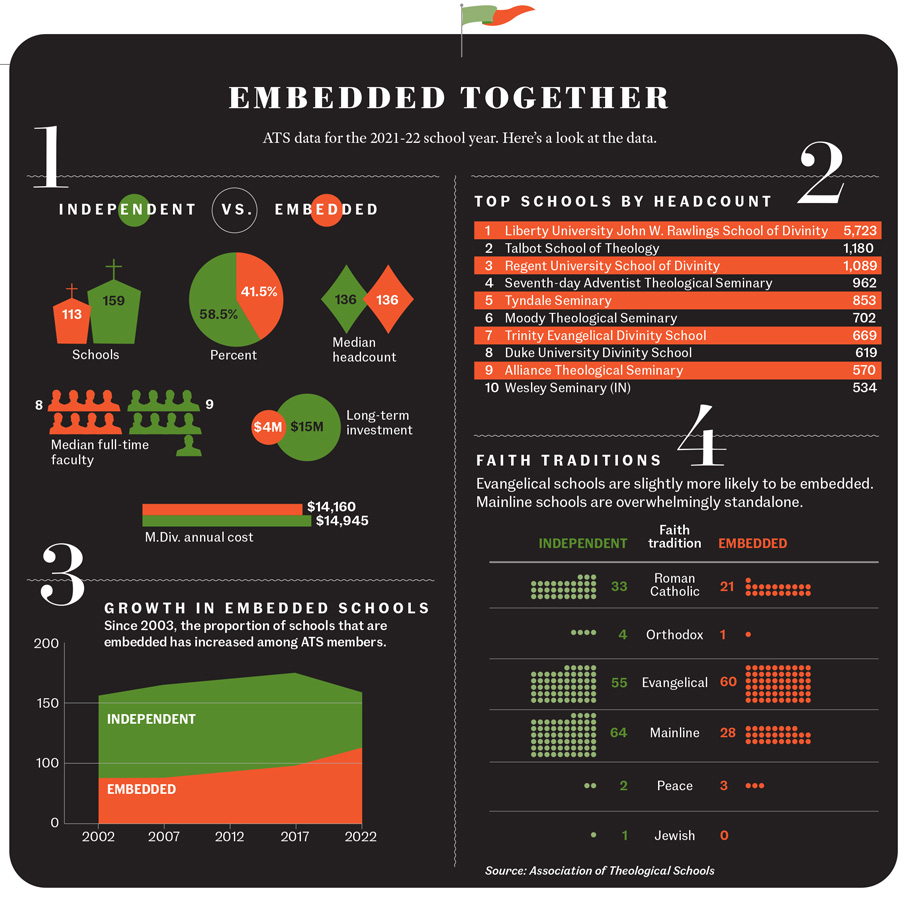
Photo illustration by Tyler Comrie
Embedded seminaries represent 41% of the member schools accredited by the Association of Theological Schools. The number of schools that are embedded has grown over the past 20 years, and with financial pressures, schools continue to view embedding as an option for long-term viability.
As part of an ongoing conversation about embedded schools and embedding, In Trust’s Matt Hufman spoke with Rev. Dr. Byron Klaus, who served 16 years as president of the Assemblies of God Theological Seminary and led the seminary into a consolidation with a Bible college and a Christian university. He is a faculty coach with the In Trust Center’s Wise Stewards Initiative and continues to work with seminaries and theological schools. Here are five takeaways. The full video interview is available here.
Expect the Trend to Continue
ATS started talking about this trend of schools embedding years ago, and it has gone as they’ve predicted. It’s going to be pushing half of all schools shortly.
This trend reflects the general state of higher education and its reshaping. In a sense, that’s our story as well. It’s a song in a different key, but it’s the same song and all the things that challenge higher ed as a whole challenge theological education in a particular way.
I think the COVID season has revealed all of the weaknesses that were already there. And while larger schools with endowments or scale can adjust accordingly over a longer period of time than theological schools can, the fact is that we don’t have room for error as theological schools.
Don’t believe the myth that your endowment or your capability to raise money for an annual fund can carry the day. There is reconfiguration going on in all of higher education. It’s changing. I think that the acceptance of that reality is the first step.
We are going to have to negotiate this new era, and boards are in charge of that. Facing reality and just swallowing deeply and saying, “We’ve got to find a way to reframe ourselves for the future,” is the starting point.
Three Key Issues
Two prominent issues of the higher ed world have been affordability and accessibility, and they now obviously include a third: equity. What’s really interesting about higher education – and particularly theological education – is that embedding is occurring because we have not directly dealt with the issues of affordability or accessibility, and we’re still wrestling with the equity issue. We have current issues of justice around equity that are very, very important.
However, theological education has been dealing with these kinds of things for a long time. Back in the late 1950s, the World Council of Churches began an initiative, and for the next 20 years, using three specific theological mandates, they basically asked the questions: What is ministry and who gets trained for the ministry? The evangelical version of that effort was called the Theological Education by Extension movement. And so these issues of affordability, accessibility, and equity – Who gets our education? – those things have been with us for a long time. And the large part of the reason that we are facing the challenge of potentially embedding is because we haven’t answered those questions adequately.
Look at the Signs
I think boards, administrations, ecclesial partners, and donors all need to be looking at certain red flags that may be signs they need to consider embedding. The presenting challenge is always, or almost always, financial, but that presenting challenge is really an indicator of some larger issues. For instance: Debt service is more than 10% of your operating budgets; tuition increases in the last five years have exceeded those of your competitors, and endowment principle has been diverted to balance budgets. Or things like: You have deferred maintenance that is 40% unfunded; you have less than 10% of your budget going to technology; you have steady enrollment declines, or your institution is being challenged by your accreditors about putting you on probation. I could go on, but those are very tangible things that tell us we have issues. We tend to read those business signs not as quickly as we should in theological education.
It’s not necessarily a question of do we embed or not. It’s a question of how we are going to continue our mission effectively.
Have the Conversation Now
A board is one of the key starting points for the discussion about embedding, and it takes real courage for a board to say, “We’re going to have to look at some other options here. We’ve had a good run here. The questions are: Do we want our mission to continue in a noticeably effective way? And are we willing to reshape our organization to serve our mission, even though it will mean losing some nostalgic pieces of what we historically have been?”
Those are very hard questions, but they need to be considered by a board. And I don’t think that we can ever ask those questions too soon.
It’s not necessarily a question of do we embed or not. It’s a question of how we are going to continue our mission effectively, given the context we find ourselves in today. Even if we were financially stable, we need to be having this conversation. But I do think that we must ask ourselves the questions of could there be another structure, or could being part of another larger structure allow us to continue our mission in an effective and sustainable way? It’s an issue of whether our mission can continue and what shape it will take into the future. Embedding is one of the ways that might occur, but that discussion needs to happen “yesterday.”
The farther down the line you get with more of the red flags being predominant, the less likely the future organization is going to look like what you’d like it to look like. The old adage is true: Pay me now or pay me later. That’s really what’s at stake here. Can our mission continue? Do we want it to continue? And what shape will it continue on in the future? Again, embedding is just one of the ways that sustaining your missionmight occur.
Talk to Others
When I went through embedding, I found people outside my faith tradition who had gone through it, and I talked to lots of them. They helped me so much because sometimes we’re so entrenched in our ecclesial culture with our unique set of issues that we can’t see the forest for the trees. I have found that theological institutions sometimes believe that their niche in higher education is so unique that nobody can really understand what they’re going through.
And in one sense, I get that. But in another sense, you need external voices looking at your circumstance because there really are common denominators that you may miss or avoid just because you don’t want to deal with the pain. You need a third party who has nothing to lose and can tell you the truth – and you need to hear it.
I understand what it is to be in the grind – there’s always a challenge or a crisis – but I think it’s really important for a board and a president to find a discussion partner.
There is not a good time where everything will be in a lull to do this. You’ve got to deal with it on the fly. The old imagery of repairing an airplane while it’s in flight – that’s the story.

Infographic by MSJONES NYC